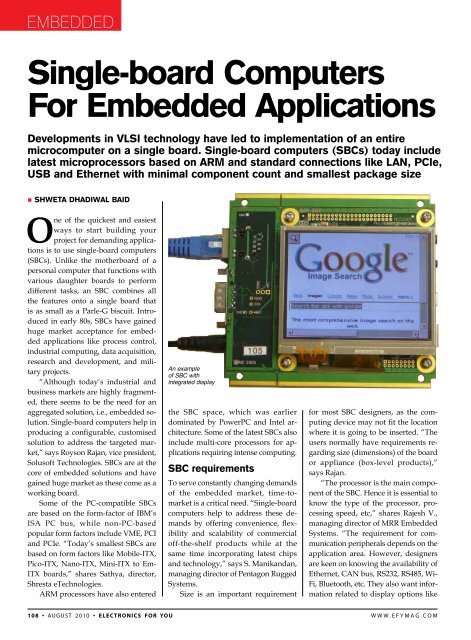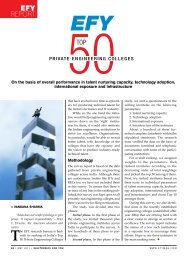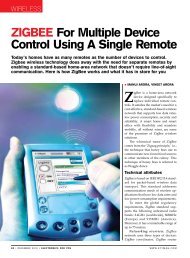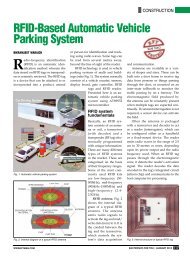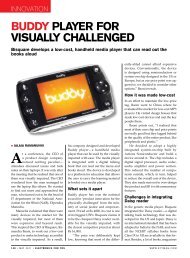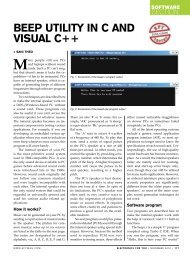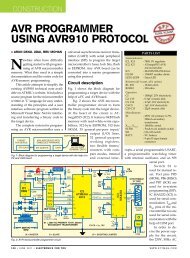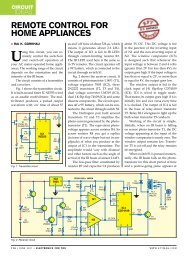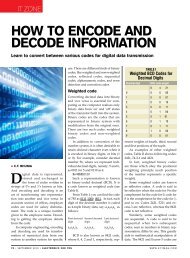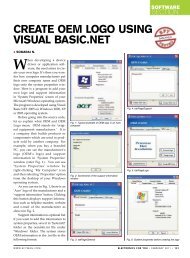Single-board Computers For Embedded Applications
Single-board Computers For Embedded Applications
Single-board Computers For Embedded Applications
Create successful ePaper yourself
Turn your PDF publications into a flip-book with our unique Google optimized e-Paper software.
<strong>Embedded</strong><br />
<strong>Single</strong>-<strong>board</strong> <strong>Computers</strong><br />
<strong>For</strong> <strong>Embedded</strong> <strong>Applications</strong><br />
Developments in VLSI technology have led to implementation of an entire<br />
microcomputer on a single <strong>board</strong>. <strong>Single</strong>-<strong>board</strong> computers (SBCs) today include<br />
latest microprocessors based on ARM and standard connections like LAN, PCIe,<br />
USB and Ethernet with minimal component count and smallest package size<br />
• Shweta Dhadiwal baid<br />
One of the quickest and easiest<br />
ways to start building your<br />
project for demanding applications<br />
is to use single-<strong>board</strong> computers<br />
(SBCs). Unlike the mother<strong>board</strong> of a<br />
personal computer that functions with<br />
various daughter <strong>board</strong>s to perform<br />
different tasks, an SBC combines all<br />
the features onto a single <strong>board</strong> that<br />
is as small as a Parle-G biscuit. Introduced<br />
in early 80s, SBCs have gained<br />
huge market acceptance for embedded<br />
applications like process control,<br />
industrial computing, data acquisition,<br />
research and development, and military<br />
projects.<br />
“Although today’s industrial and<br />
business markets are highly fragmented,<br />
there seems to be the need for an<br />
aggregated solution, i.e., embedded solution.<br />
<strong>Single</strong>-<strong>board</strong> computers help in<br />
producing a configurable, customised<br />
solution to address the targeted market,”<br />
says Royson Rajan, vice president,<br />
Solusoft Technologies. SBCs are at the<br />
core of embedded solutions and have<br />
gained huge market as these come as a<br />
working <strong>board</strong>.<br />
Some of the PC-compatible SBCs<br />
are based on the form-factor of IBM’s<br />
ISA PC bus, while non-PC-based<br />
popular form factors include VME, PCI<br />
and PCIe. “Today’s smallest SBCs are<br />
based on form factors like Mobile-ITX,<br />
Pico-ITX, Nano-ITX, Mini-ITX to Em-<br />
ITX <strong>board</strong>s,” shares Sathya, director,<br />
Shresta eTechnologies.<br />
ARM processors have also entered<br />
An example<br />
of SBC with<br />
integrated display<br />
the SBC space, which was earlier<br />
dominated by PowerPC and Intel architecture.<br />
Some of the latest SBCs also<br />
include multi-core processors for applications<br />
requiring intense computing.<br />
SBC requirements<br />
To serve constantly changing demands<br />
of the embedded market, time-tomarket<br />
is a critical need. “<strong>Single</strong>-<strong>board</strong><br />
computers help to address these demands<br />
by offering convenience, flexibility<br />
and scalability of commercial<br />
off-the-shelf products while at the<br />
same time incorporating latest chips<br />
and technology,” says S. Manikandan,<br />
managing director of Pentagon Rugged<br />
Systems.<br />
Size is an important requirement<br />
for most SBC designers, as the computing<br />
device may not fit the location<br />
where it is going to be inserted. “The<br />
users normally have requirements regarding<br />
size (dimensions) of the <strong>board</strong><br />
or appliance (box-level products),”<br />
says Rajan.<br />
“The processor is the main component<br />
of the SBC. Hence it is essential to<br />
know the type of the processor, processing<br />
speed, etc,” shares Rajesh V.,<br />
managing director of MRR <strong>Embedded</strong><br />
Systems. “The requirement for communication<br />
peripherals depends on the<br />
application area. However, designers<br />
are keen on knowing the availability of<br />
Ethernet, CAN bus, RS232, RS485, Wi-<br />
Fi, Bluetooth, etc. They also want information<br />
related to display options like<br />
108 • August 2010 • electronics for you www.efymag.com
<strong>Embedded</strong><br />
<strong>Single</strong>-<strong>board</strong> computer with ARM processor<br />
VGA, touchscreen and TFT display.”<br />
Other requirements include analogue<br />
inputs/outputs (I/Os), digital I/Os,<br />
voltage and current input.<br />
Sathya shares, “Longevity of up to<br />
three-five years and heavy technical<br />
support have always been a concern<br />
for the designers. They also look for<br />
embedded operating-system support<br />
and possible security issues.”<br />
SBCs can be used in a variety of<br />
applications and the processor requirement<br />
varies. “<strong>For</strong> example, in<br />
an industrial environment, where the<br />
importance is given to ruggedness of<br />
the box rather than the CPU performance,<br />
the preference would be fanless<br />
processors like those from Intel (Atom)<br />
and VIA. But for billing systems, which<br />
call for more processing power, the<br />
SBC may require a dual-core or higherperformance<br />
processor,” explains<br />
Sathya. “<strong>For</strong> a network appliance, it<br />
will be the external interface like LAN<br />
port that plays an important role, while<br />
in a PDA or other handheld, where<br />
integration on the chip is important<br />
in compact space, it is based on ARM.<br />
<strong>For</strong> high-performance defence applications,<br />
where the processing speed (in<br />
million instructions per second (MIPS))<br />
plays a key role in the CPU selection, it<br />
will require PowerPC core,” he adds.<br />
Manikandan shares, “Industrial<br />
computers focus on improved mechanics<br />
to overcome the limitations posed<br />
by the standard consumer PC set-up.”<br />
The ultimate deciding factors thus are<br />
size, power consumption, availability<br />
of compatible software and peripheral<br />
hardware, and the low mean time between<br />
failures (MTBF), all at the most<br />
affordable price point.<br />
ARM-core SBCs<br />
<strong>Single</strong>-<strong>board</strong> computers with ARMbased<br />
microprocessor have made a<br />
big impact on the embedded sector.<br />
Though the first truly functional SBC<br />
was based on Intel’s C8080A and<br />
C1702A (Intel’s first EPROM), today,<br />
there are hundreds of processors that<br />
are used in single-<strong>board</strong> computers.<br />
ARM, which was prevalent in the<br />
handset space, has entered single<strong>board</strong><br />
computers with its Cortex A<br />
series processors.<br />
At the <strong>Embedded</strong> Systems Conference<br />
Sillicon Valley, a single-<strong>board</strong> computer<br />
based on 800MHz Cortex A8 CPU was<br />
showcased by Microsys. An interesting<br />
aspect of this single-<strong>board</strong> computer<br />
is its cost, which is roughly $100 to<br />
$300 less than an Intel-based <strong>board</strong>.<br />
Freescale’s single-chip solution as<br />
opposed to two-chip solution for Intelbased<br />
<strong>board</strong> is one of the contributors<br />
to the price drop.<br />
Rajesh shares, “Some of the compact,<br />
full-featured SBCs based on<br />
Cirrus EP9302 ARM9 CPU provide a<br />
standard set of on-<strong>board</strong> peripherals.<br />
These low-cost Linux computers are<br />
completely manufactured in India to<br />
benefit the designer’s local needs.”<br />
“The Mini2440/MICRO2440 is a<br />
low-cost single-<strong>board</strong> computer based<br />
on Samsung’s S3C2440 ARM920T<br />
core. It supports WinCE 5.0/6.0,<br />
Linux, Android and Ubuntu, making<br />
it simple and suitable for applications<br />
like industrial control, check-out facilities,<br />
meters, safe monitoring, medical<br />
instruments, high-end embedded applications<br />
and intelligent terminals,”<br />
shares Pritesh Patel, managing director,<br />
Amp Tronics.<br />
Beagle Board is another popular<br />
single-<strong>board</strong> computer that is powered<br />
by a 1GHz ARM Cortex A8 processor.<br />
The ITX world<br />
Many vendors today offer VIA Technologies’<br />
latest SBCs based on the<br />
new super-scalar Nano-E processors.<br />
“The EPIA embedded <strong>board</strong>s from<br />
VIA Technologies features low-power<br />
embedded processors, core logic, networking,<br />
connectivity and multimedia<br />
components. Vendors develop their<br />
own SBCs based on a variety of form<br />
factors from the company, namely,<br />
Mini-ITX, Nano-ITX, Pico-ITX and<br />
Pico-ITXe embedded <strong>board</strong>s” shares<br />
Sathya.<br />
Mobile-ITX is currently the smallest<br />
form-factor (6x6cm 2 ) <strong>board</strong> based on<br />
x86 platform. It brings ultra-compact<br />
and extremely light-weight devices to<br />
the market. The Pico-ITXe form factor<br />
(10x7.2cm 2 ) was adjudged as ‘Best<br />
Choice’ at Computex Taipei 2009 for its<br />
small form factor and stackability. Pico-ITXe<br />
is adopted by the Small <strong>For</strong>m<br />
110 • August 2010 • electronics for you www.efymag.com
<strong>Embedded</strong><br />
Comparison with evaluation and development <strong>board</strong>s<br />
A single-<strong>board</strong> computer is a printed circuit <strong>board</strong> constructed using a single<br />
microprocessor/microcontroller and all other peripherals like ADC/DAC, input/outputs,<br />
memories, RS485 port, Ethernet port, VGA, RS232 port and GSM/GPRS on the same<br />
<strong>board</strong>. It is a face-less computer mainly for industrial applications that can be completely<br />
customised to fit the requirement.<br />
“A single-<strong>board</strong> computer is a printed circuit <strong>board</strong> with all the components and wiring<br />
to make a computer. Even the ports required to communicate to the outside world are<br />
included. What’s missing is the chassis—the box that houses the SBC,” shares Royson<br />
Rajan, vice president, Solusoft Technologies.<br />
The main difference between SBCs, evaluation <strong>board</strong>s and development <strong>board</strong>s is<br />
that the SBC is concluded as a final product. “The end production/manufacturing of new<br />
product includes the same SBC as was used during development, while evaluation and<br />
development <strong>board</strong>s support the development and are not used as the final product,”<br />
explains Rajesh V., managing director, MRR <strong>Embedded</strong> Systems. “Evaluation <strong>board</strong><br />
have limited features to evaluate the process that the <strong>board</strong> is meant for. <strong>For</strong> example,<br />
if the project includes Ethernet, CAN/LIN, battery charger and SD card/USB, the design<br />
engineer needs separate evaluation <strong>board</strong>s for each of these, to make sure that it works<br />
the way he wants before integrating all these together. A development <strong>board</strong> is used for<br />
developing the entire project.”<br />
Factor Special Interest Group (SFF-SIG)<br />
and is an open standard.<br />
The success of VIA’s Mini-ITX has<br />
increased the use of SBCs in power<br />
supplies, slim-line drivers, Flashto-IDE<br />
adpators and many handy<br />
computing components. “Mini-ITX<br />
17x17cm 2 is targeted at new-generation,<br />
low-power, small-size, infotainment<br />
systems to enable innovative<br />
developments,” says Sathya. Some of<br />
the latest offerings include SBCs using<br />
Intel’s Atom CPU. It’s a huge leap forward<br />
exploding its popularity between<br />
home users and hobbyists. Many<br />
SBC manufacturers have realised the<br />
potential in Mini ITX form factor and<br />
offer several products in this form factor<br />
using either VIA’s chips or Intel’s<br />
chipsets.<br />
EBX: Fit for Pentium<br />
The <strong>Embedded</strong> Board eXpandable<br />
(EBX) offers suitable features to support<br />
embedded designs with high<br />
performance. It serves as the right mix<br />
of size (20.32×14.6 cm 2 ), economy and<br />
functionality, which makes it suitable<br />
to embed Pentium CPUs. Many OEMs<br />
are able to include high-performance<br />
graphics and advanced networking<br />
on EBX.<br />
Derived from Ampro Little Board<br />
form-factor, EBX combines a standard<br />
footprint with open interfaces.<br />
The EBX standard is the result of collaboration<br />
between industry leaders,<br />
Motorola and Ampro, to unify the<br />
embedded computing industry on a<br />
small-footprint embedded single-<strong>board</strong><br />
computer standard. This form-factor<br />
is small enough for deeply embedded<br />
applications, yet large enough to contain<br />
the functions of a full embedded<br />
computer system (CPU, memory, mass<br />
storage interfaces, display controller,<br />
serial/parallel ports and other system<br />
functions).<br />
Built-in display function<br />
Advantages of SBCs<br />
1. <strong>Single</strong> <strong>board</strong> with features integrated<br />
in a compact size<br />
2. Availability of backplanes and<br />
several slot configurations such as<br />
VME, PCI, ISA and Ethernet<br />
3. Availability of more slots for<br />
interconnect<br />
4. Minimal component count<br />
5. Quick time-to-market<br />
6. More power-efficient, lighter and<br />
more reliable<br />
Today’s embedded systems are incomplete<br />
without a human-machine<br />
interface, where use of high-end<br />
displays like VGA, TFT and touch<br />
screens is rapidly growing. As these<br />
display interfaces become affordable,<br />
the usage becomes more lenient. “To<br />
support the fully-functional, featurerich<br />
product development, SBC<br />
manufacturers have started integrating<br />
display as well as link to inputs/<br />
control,” shares Patel.<br />
“SBCs traditionally had 7-segment<br />
LED displays useful for control<br />
applications. Easy and low-cost availability<br />
of LCDs, TFT displays as well<br />
as touchscreen panels have made their<br />
way on SBCs. These are suitable for applications<br />
like automation, automotive<br />
electronics, medical devices and GPS<br />
navigation systems,” explains Patel.<br />
Display panel manufacturers are<br />
realising a large and growing market<br />
in industrial areas. The display units<br />
are made rugged to survive and work<br />
in temperature range of -25°C to<br />
+85°C. Such rugged systems can be<br />
fitted into industrial computers and<br />
automation.<br />
Open source SBCs<br />
Open source software and hardware<br />
have become increasingly famous<br />
for development as these offer all<br />
the flexibility to change and use the<br />
way a designer wants to. There are<br />
several single-<strong>board</strong> computers that<br />
come under open source hardware<br />
category, allowing design development<br />
with reduced time-to-market<br />
and low cost.<br />
One of the commonly used open<br />
source SBCs is the Beagle Board<br />
(7.6×7.6cm 2 ) based on Texas Instrument’s<br />
OMAP3530 system-on-chip.<br />
The USB-powered Beagle Board offers<br />
a low-cost, low-power solution that<br />
unleashes laptop-like performance<br />
and expandability without the bulk<br />
expense or noise of a typical desktop<br />
machine.<br />
Another widely used SBC is OMAP<br />
L138 dual-core processor based Hawk<br />
Board that also includes floating-point<br />
DSP C674x application from TI. Hawk<br />
Board is an ultimate tool for digital<br />
media and storage applications with<br />
a wide range of peripheral support.<br />
An SBC named Gumstix, of the size of<br />
www.efymag.com<br />
electronics for you • August 2010 • 111
<strong>Embedded</strong><br />
a chewing gum stick, was developed<br />
as a hobby project but has become<br />
increasingly popular in commercial<br />
applications like power management<br />
metering, medical devices, security<br />
devices, unmanned aerial vehicles, and<br />
wireless and handheld products. It<br />
has two product lines, one based on<br />
TI OMAP and the other based on<br />
Marvell XScale processor. Some of the<br />
other open source options are Leopard<br />
<strong>board</strong> and Maple <strong>board</strong> that allow full<br />
computing capability.<br />
Latest picks<br />
SBCs are traditionally known for industrial<br />
computing applications. However,<br />
Samsung recently introduced<br />
an SBC virtualisation environment<br />
to bring it to office. The environment<br />
will strengthen internal security and is<br />
based on a test project with Samsung<br />
SDS.<br />
A company called Intercept Concept<br />
claims that its ultra-low-power<br />
single-<strong>board</strong> computer based on<br />
Freescale’s PowerPC provides Gigabit<br />
Ethernet interfaces for high-performance<br />
network connectivity, redundant<br />
fail-safe links, powerful control<br />
elements for network switches, data<br />
storage sub-systems, network appliances,<br />
and print and imaging devices.<br />
The latest offering from GE Intelligent<br />
Platforms, a 6U VMEbus SBC<br />
based on Freescale’s QorIQ dual-core<br />
processor, delivers around ten times<br />
the processing performance depending<br />
on applications. Many such PowerXtreme<br />
SBCs are deployed in demanding<br />
military/aerospace applications in<br />
the US and Europe.<br />
California-based ACCES I/O Products<br />
offers multiple-function single<br />
<strong>board</strong>s through optically isolated<br />
inputs. This allows individual channelto-channel<br />
isolation, that is, every<br />
channel is separated physically and<br />
electrically. The solid-state FET outputs<br />
capable of switching up to 3A<br />
each and two 16-bit analogue inputs<br />
make this module suitable for control<br />
and instrumentation application.<br />
ADLINK Technology announced<br />
The ITX form factors from VIA Technologies<br />
its latest LittleBoard 735 EBX SBC<br />
based on Intel Atom N270 processor at<br />
1.6 GHz, codenamed ‘Diamondville,’<br />
at the ESC San Jose in April. The <strong>board</strong><br />
combines Navy Pier platform, Atom<br />
N270 with ADLINK Extreme Rugged<br />
design methodology to create a<br />
feature-rich upgrade path for previous<br />
end-of-life products. It is designed to<br />
tolerate shock, vibration, humidity and<br />
temperature extremes.<br />
The FeaturePak Initiative, originated<br />
by Diamond Systems, was<br />
launched at the <strong>Embedded</strong> World<br />
tradeshow in March 2010. Gurunatham<br />
G.V., managing director, Electro Systems<br />
Associates, shares, “This new<br />
standard defines a highly-compact,<br />
low-profile and inexpensive way to<br />
add configurable input/output functions<br />
to embedded systems.” He adds<br />
that the tiny FeaturePak modules that<br />
are just 4.3×6.5 cm 2 (1.70×2.55 inch 2 ) in<br />
size can be used for providing snap-in<br />
options or upgrades for off-the-shelf<br />
single-<strong>board</strong> computers and computeron-module<br />
base<strong>board</strong>s, or as building<br />
blocks to simplify the development of<br />
fully-custom embedded electronics.<br />
Gaming is one of the most aggressively<br />
growing industries. “<strong>Single</strong><strong>board</strong><br />
computers of MB 62000 series<br />
are designed specifically for the gaming<br />
and amusement industry. These<br />
are based on Intel’s GMA 900 graphics<br />
engine for 2-D/3-D applications and<br />
are supported by VGA+LVDS dualdisplay<br />
option. They also feature highlevel<br />
security by TPM 1.2, FPGA and<br />
Authenix chip, and are ideally meant<br />
for video slot machines, amusement<br />
game machines, master units of roulette<br />
machines, downloadable gaming<br />
terminals, high-end vending machines,<br />
ATM/cash machines and kiosks. Gaming<br />
manufacturers benefit from single<strong>board</strong><br />
features like integrated and<br />
economical assembly and purchasing<br />
costs,” shares Rajan.<br />
In sync with technological<br />
advancements<br />
The concept of single-<strong>board</strong> computer<br />
is now new. It’s a system that has<br />
survived for more than two decades<br />
now and evolved with changing technologies.<br />
By principle, it is a single<br />
<strong>board</strong>, but expandability is the most<br />
important feature of single-<strong>board</strong><br />
computers. Due to standardisation<br />
and aggregation, expansion options<br />
are backward-compatible and<br />
forward-looking.<br />
With the advancement in silicon<br />
technologies, high-end processors like<br />
ARM-based processors and Intel’s<br />
multi-core processors have found a<br />
space on the tiny <strong>board</strong> to support<br />
high-performance products.<br />
Connectivity is another trend that<br />
has been well-incorporated in single<strong>board</strong><br />
computers. SBCs are ready with<br />
Wi-Fi, 3G, Ethernet, USB, Bluetooth,<br />
ZigBee and other connectivity options.<br />
As embedded products become more<br />
interactive, display options are supported<br />
on single-<strong>board</strong> computers to<br />
make these a complete, feature-rich,<br />
ready-to use solution for a variety of<br />
applications. •<br />
The author is a senior technology journalist at EFY<br />
112 • August 2010 • electronics for you www.efymag.com


